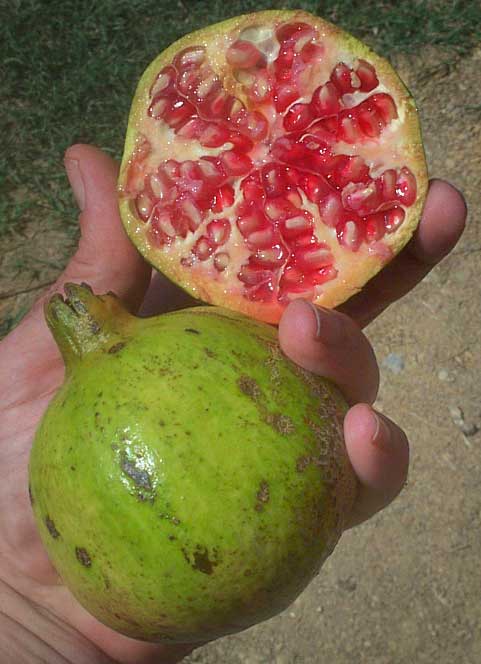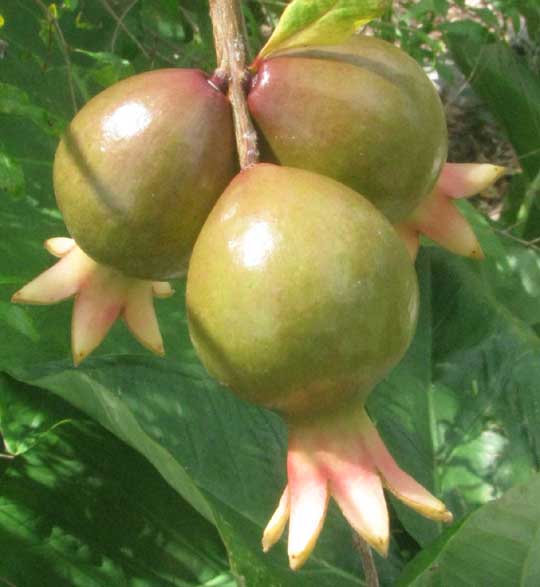Excerpts from Jim Conrad's
Naturalist Newsletter
from the August 17, 2007 Newsletter issued from issued from Sierra Gorda Biosphere Reserve, QUERÉTARO, MÉXICO
POMEGRANATES/ GRANADAS
The mushroom-picking lady gave us some pomegranates from next to her house. You can see one I cut open below:

Pomegranate fruits are thick-skinned, several-celled berries with seeds enmeshed in juicy pulp. It's the pulp you eat, which can be very sweet and juicy. The seeds are so soft that I just chew them, but I suspect some finicky sorts spit them out.
Notice how the fruit bears a "crown" consisting of 5-7 thick, leathery sepals. Sepals are the separate divisions of the usually green, leafy, cuplike calyx appearing beneath the corollas of typical flowers. Sepals usually wither and drop away as a blossom's ovary develops into a fruit, but pomegranates for some reason decided they needed those sepals.
Back when I studied botany pomegranate fruits and flowers were regarded as so weird that pomegranate species were assigned to their own two-species family, the Pomegranate Family, or Punicaceae. However, recent studies place them into the Loosestrife Family, the Lythraceae, the most famous member of which is the Crape Myrtle.
Pomegranate plants are deciduous shrubs or trees up to 20 feet high. They're native of southern Asia but have been naturalized in many places. They're PUNICA GRANATUM, in Spanish called Granadas.

from the March 18, 2012 Newsletter issued from Hacienda Chichen Resort beside Chichén Itzá Ruins; limestone bedrock; elevation ~39m (~128ft), N20.675°, W88.569°; central Yucatán state, MÉXICO
POMEGRANATES FLOWERING
On a 10-ft-tall (3m) bush in Pisté you can see the orange-red, two-inch (5cm) blossoms shown above. At the right in that picture you see the blossom's curiously large, unusually leathery, surprisingly reddish calyx subtending a somewhat larger wrinkled corolla. At the left the corolla has fallen off leaving the calyx's interior walls bristling with pollen-producing stamens. It's more normal for stamens to arise from below the ovary or from the walls of a corolla, not the walls of a calyx.
Once the flowers' ovaries have matured a little we start seeing our future Pomegranates, as shown below:

The developing fruits in that picture, by the way, are good examples of maturing inferior ovaries. Inferior ovaries are those in which the stamens, calyx and corolla arise above the ovary instead of at its base. The ovaries in the picture are only about as thick as a finger. The mature pomegranates will be about the size of an orange.
Pomegranates are native to southern Asia but grow wild in the Mediterranean, South America, and the southern US. Many cultivars exist, including double-flowered and dwarf ones.